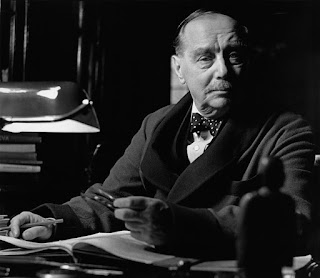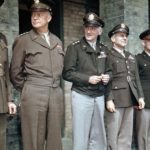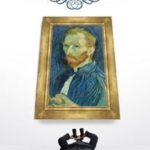Originally published in “The Wellsian,” No. 25, © 2002 The H.G. Wells Society, UK.
My devotion to H.G. Wells goes back a little more than twenty years, when I discovered there was a novel that had inspired the Orson Welles production of The War of the Worlds, a record of which I had been listening to over and over and over again. It was in my Junior High School library that I first discovered the tome, illustrated in that printing by the noted artist the late Edward Gorey. The War of the Worlds immediately became my favorite novel, and has remained so to this day. I even went back years later and traded for that very copy from the library.
As I grew older and read more of Wells’s novels and learned more about the man brandishing the pen, I became fascinated with his multi-faceted and often contradictory life style. Having been raised very conservative in America’s heartland, I struggled at times to rationalize the liberal republican (sort of an oxymoron here in America) whose writing captivated me with its grace, clarity, and refinement, with the man whose sensational behavior stirred up at times as much tongue wagging as his ideas.
It was while my then future wife and I were on my long dreamt of pilgrimage to Woking in 1996 that my mission crystalized out for me. While strolling down Maybury Road and becoming frustrated that I might not find the house in which Wells wrote his masterpiece, we met a local who walked with us down to the post office to ask if anyone might know which was the old Wells home. I explained to him my devotion to H.G. Wells and his works, and the man said; “ah yes, Wells. Didn’t he write 1984, too?”
With that I decided to do what I could to bring the name H.G. Wells back into the public lexicon – accurately. We did, by the way, find the Wells house a short time later; and a vial of sand from the Horsell Common sand pits sits on my desk even now…
What follows are three articles I wrote over a one year period for a trade publication called Trendline Magazine. I work as an archivist and catalog writer for Manion’s International Auction House which publishes a new issue of Trendlineevery five weeks. The magazine has recently moved into the electronic age and is available to anyone with Internet access at <www.manions.com> [the company dissolved in early 2014 and their web presence has vanished – ed.]. Though previously available only to those with a subscription to the auction catalogs, I am pleased to see it now made available to the entire world. The Auction House has been in business thirty years, servicing primarily the international military collector community, and is recognized around the world as an authority on all aspects of both military and civilian collectibles.
My articles reflect (to an extent) the interests of Manion’s clientele. I have attempted no in-depth scholarly reappraisal of Wells; rather my aim is simply to educate Mr. Everyman about some of the more obscure and fascinating aspects of H.G. Wells’s life and work. I extend further thanks to J.S. Partington for directing me to other pieces of research done by Society members before my entrance, and to Rose Tilley whose input regarding the Telpherage System is very much appreciated.
Part I: The First World War and H.G. Wells
To many today the name H.G. Wells means little more than the author of classic science fiction stories like The War of the Worlds, The Time Machine, The Island of Dr. Moreau, The Invisible Man, and others. In reality these masterpieces were only Wells’s earliest forays into the literary world. Wells is also known today as something of a prophet, and sometimes an uncritical apostle of scientific progress. Neither perception is wholly accurate.
By the early part of the twentieth century Wells had turned his attention and prolific pen to more social topics such as the emancipation of women, a League of Free Nations, and speculations on the future of mankind as a whole. He viewed the rising tide of nationalism in Germany throughout the Victorian and Edwardian ages with alarm, and was not to surprised by the outbreak of the First World War in 1914.
H.G. Wells was a Socialist, but his Socialism had nothing to do with the Marxist strain the majority of Americans today perceive as ‘Socialism’. In fact Wells was a vociferous opponent of Marxism and an unrelenting critic of Communism in Lenin’s Soviet Union. Wells’s socialism was very unique, being far more influenced by Robert Owen’s and Henri Saint Simon’s ideas; and was often at odds with most of his fellow Socialists in England like George Bernard Shaw, Beatrice and Sidney Webb, and Bertrand Russell. The republican Wells had already clashed with Shaw during his time in the Fabian Society, and once again found himself criticizing Shaw’s (and Russell’s) objection to British involvement in the First World War. In the process he wrote a pamphlet aimed at those undecided between “participation and war resistance,” entitled The War that Will End War. The title became proverbial to say the least.
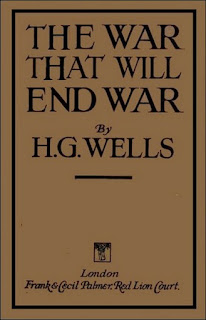
Though bothered by Britain’s predictable patriotic mantra “For King and Country” as well as other aspects of the war, Wells saw in it an opportunity to arrest the militarism and nationalism that prevented his desired ‘international brotherhood of Man.’ Though his personal morale ebbed and flowed between understanding the necessity for and yet abhorrence of the war, Wells rose to the challenge admirably.
In response to the war, the British government had created two new ministries separate from the Foreign Office. Wells was already close to one of its Ministers, Lord Northcliffe, and it did not take much convincing for Wells to begin working in a still obscure role for the Ministry of Propaganda. Though their task was ill-defined, and Wells began to realize he alone regarded this conflict as an opportunity to create a new ‘League of Free Nations’, the group managed to draw up “a plain statement of War Aims.”
In 1916 there was a trend of inviting writers and artists to the front to see the war for themselves. Wells visited the Italian, French and British fronts, and for a time had author C.E. Montague as a guide. He chronicled the trip in War and the Future: Italy, France and Britain at War (1917). But Wells was not all that impressed by the front lines and records in his Experiment in Autobiography that he “might have been doing extremely useful war work at home.” He came away from the experience believing one of the greatest horrors of war was boredom.
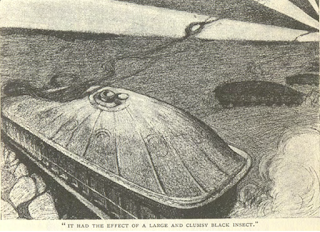
In fact something new to this war had been inspired by him years before. ‘The Land Ironclads’ was published in the Strand Magazine during 1903, depicting massive land dreadnoughts rolling across the land. These primitive tanks fired the imagination of Winston S. Churchill, who pushed development of these new weapons against the “traditional instincts” of the British army; even after Lord Kitchener had denied them as simply “mechanical toys.” Wells too believed his ironclad idea properly developed could have brought about a faster end to the First World War, but for the immutable habits of the fiercely conservative British military complex. Of course things would be very different with tanks in the next war…

But of course Wells was not finished with his contributions yet. During one especially stormy night after returning from the front, he was haunted by visions of the communication trenches “swamped and swimming in mud and a miserable procession of overloaded ‘Tommies’ struggling up to the front line along the wet planks.” Wells’s inventive flash was of a “Mobile Telpherage System” which would transport men and supplies to and from the front by way of ‘T’ shaped poles with an erector wire. This primitive ‘ski lift’ could be pulled up for use or laid flat, and two tractor wires would work on the arms of the ‘T’. Power was to be supplied by a motor lorry at the base of the line.

Wells presented his idea to Churchill who in turn placed Wells in touch with E.V. Haigh at the Ministry of Munitions and Lieutenant J.A. Leeming of the Royal Engineers, who set the Trench Warfare Department in motion. Three versions of the system were developed, built and patented by Leeming and his engineers and tested at Clapham Common, Richmond Park, and Longmoor. The second pattern was judged most successful and emerged before the end of the war and used effectively by both British and Canadian troops. Among the Telpherage System’s most remarkable attributes was that it could be moved forward as fast as infantry could advance. Individual men could move parts of it, and it could transport supplies or wounded men to and from the front lines in an endless stream.

H.G. Wells Society member Rose Tilley has done invaluable research into the ropeways and found a 1917 report on their success that eluded Wells while he was writing his autobiography. This copy of the original had remained obscured by a quirk of fate; a clerk, seeing on it the word ‘aerial’ filed it with Royal Flying Corps reports. The report ends with:
 |
| Wells’s original notes |
It is possible to supply as much ammunition to the forward trenches during the hours of darkness with fifteen men as against 1,500-2,000 men carrying the same, to say nothing of the saving of life.
Although he was never to know the success of his inventive flash, Wells’s Ropeways are well documented by this report and sixteen monochrome prints dated 26 November 1917 in the Public Records Office at Kew as the “Leeming Portable and Collapsible Aerial Ropeway.”
Part II: The Evolution of Camouflage During the First World War
Many of the legacies of the First World War stem from the acceleration in evolution it provided for certain aspects of the “art” of war. If close order attacks and traditional horse mounted Cavalry were rendered generally obsolete by trench warfare, there were progressive (if I may use the term) elements this “war that will end war” sparked. The machine gun became as important as the rifle (if not more so), and the tank and aeroplane provided new platforms for this most formidable weapon. Also becoming apparent was the vital necessity of mobility along shifting front lines, aerial reconnaissance, as well as the importance of artillery and the industrial complex to support it. But certainly one of the most under-appreciated aspects of this war that saw radical transformation was the art of camouflage. Until this dawn of mechanized warfare, close order attack and retreat required no camouflage. But even after the first couple of years of the war which saw the wholesale slaughter of a generation of young men, the value of camouflage seemed understood by only a few.
The outdated yet strident conservatism that reigned within the upper echelons of German and British military organization were so thoroughly entrenched that neither side fully appreciated at first the advantages of camouflaging both material and men. Fortunately for the Allies the French and Italians did. British writer and journalist H.G. Wells made tours of the frontlines and wrote of them in Italy, France and Britain at War published early in 1917. In it he tells of how the Italian camouflage was designed not only to disguise, but also to create lifelike models of guns, camps, and trenches to convince and draw away enemy Austrian fire.
French commanders, led by the Parisian portraitist Guirand de Sceuola (who was then serving in the artillery) also seemed to understand this new science better than the British, and took their cues from the coloration of animals in an effort to “break the outline.” The French general staff were indeed so impressed with this concept that several other artists were recruited into a mobile corps that traveled from position to position along the frontlines camouflaging everything from observation posts to artillery and airfields.
Given this it is not difficult to understand the frustration that the patriotic H.G. Wells felt towards his own nation’s military leadership (whom he noticed were still wearing spurs on their boots despite the fact that they were nowhere near a horse!) and their initial obstinance towards camouflage. Begrudging first attempts were to feebly splash paint on guns, or paint a hanger grey-green. At length camouflage was indeed adopted, albeit hesitatingly, which Wells described as only he could:
…At any rate very many of the British tents look as though they had been dabbed over by a protesting man muttering ‘foolery’ as he did it. With a good telescope the chief points of interest in the present British front in France would be visible from Mars.
However, French progress and success with camouflage caused the British to appoint Solomon J. Solomon to create with others tank camouflage under the command of Royal Engineer Lt. Col. Francis Wyatt. Germany too had learned its lesson and turned to avant garde artist Franz Marc (who was then serving in the cavalry) to paint what he would later call “Kandinskys” (after the famous abstract artist) on tarpaulins. The increasing debt camouflage owed to abstract art was even noticed by Picasso when he claimed “it is we that have created that” upon seeing a camouflaged cannon in Paris.
Of course in a clear sky or away at sea complete invisibility was not the goal. The ‘Dazzle’ pattern was developed as an offshoot of the Disruptive Pattern in order to mislead German U-boat commanders. It was not to obscure the true distance of the target as much as to cause confusion about the proper course the Captain should take for engagement. Practical tests yielded stunning results, and the British Admiralty ordered the entire Mercantile Marine fleet camouflaged in October 1917.
The reported German reaction was one of amusement and belief that the Allies were short on normal paint. But it was not long until Germany realized its value and began imitating the Allies by incorporating the Dazzle pattern on their ships as well as the upper portions of their aircraft. The familiar ‘lozenge’ pattern appeared around 1916 and culminated in its garish confusion by 1918. But just as H.G. Wells had seen in his survey of ground based British commanders, the Royal Flying Corps were reticent to apply these patterns to their aircraft. Nevertheless, disruptive camouflage had made its irreversible impact on weaponry.
The only real instance of camouflage being adopted as part of a uniform comes from the Germans painting their M-16 steel combat helmets with the classic ‘tortoise shell’ disruptive pattern in drab colors. Concessions to warfare’s evolving conditions on the individual were made by the French with the adoption of the ‘horizon blue’ or ‘tricolor grey’ uniforms to replace the red trousers they began the war with. ‘Feldgrau’ was the traditional color of the German uniform and this was eventually modified lighter, and a drab cloth protective field cover was placed over their familiar spiked, or Pickelhaube helmets. Coordinated uniform camouflage was still a couple of decades away and would surface first as field uniform smocks in Himmler’s SS Infantry divisions.
Part III: Iron Saviors
The prophetic qualities in some of Wells’s writings is to this day the subject of many debates among my colleagues in the H.G. Wells Society, as well as among mainstream historical revisionists. Recently I came across another aspect of this remarkable man’s life involving the evolution of armoured vehicles, the tank in particular, that is certainly worth further exploration in these pages.
During February 1940, there erupted a feud between H.G., the BBC, and Major-General Sir Ernest Swinton, over a claim Swinton made, on a BBC broadcast, that he had invented the tank during the First World War after being inspired by the sight of caterpillar tractors working in a field. Wells was 73 and beginning to show signs of old-age petulance that was to become even worse before his death in 1946. He was already very experienced at locking horns with the British Army’s strident conservatism during the First World War, and very forcefully disputed Swinton’s claim in a letter to the Listener. As evidence, he offered his 1903 Strand Magazine story ‘The Land Ironclads’, which in fact does depict tanks quite clearly. He later wrote in a memorandum, “I lost my temper in proving this,” and was rewarded with a libel suit from Swinton for defamation of character, not over whether or not he had actually invented the tank. Curiously enough, Wells was more disturbed by the BBC’s asking him to apologize and avoid a costly court action than by the injustice done him by Swinton.
Wells never actually claimed to have invented the tank himself, but wrote in Italy, France and Britain at War, of having a “peculiar interest” in them. “The filiation was indeed quite traceable. They were my grandchildren – I felt a little like King Lear when I first read about them. Yet let me state at once that I was certainly not their prime originator. I took up an idea, manipulated it slightly, and handed it on.” It remains an oddity that Wells was not often able to make the British military and Ministry of War take his inventions very seriously. His “Telpherage System” invented during the First World War met with what seemed rather half-hearted testing, and he said about tanks in his 1934 Experiment in Autobiography that “it is absurd that my imagination was not mobilized in scheming the structure and use of the contrivances. When I heard about the tanks I felt bitter and frustrated…”
Sadly, the facts had become so muddled as to be irrelevant and Swinton won; the settlement proposed by the BBC saw Wells pay £500, whilst the BBC paid only £100. Later Wells wrote in a memorandum that the case “is merely one sample of the BBC behaviour, and if the same negligence, evasiveness and timidity on the part of its officials that has let me down in this affair and wasted my time and some of my money, passes without enquiry, it may manifest itself again tomorrow upon some fresh and immediately disastrous occasion.” Still, £500 sounds like a bargain for a man’s character, even in 1940…
In ‘The Land Ironclads’ Wells stumbled upon a vision that depicted quite accurately the revolution in warfare the tank would bring to the First World War. He did not foresee that Britain’s military leadership would not evolve adequately as to use these new ‘contrivances’ to their fullest possibilities. Wells’s imagined ironclads were much larger than what later came to be, and the discipline required for their practical operation more resembled what you would find on a ship or submarine. The mechanism itself was massive. In fact, Wells later wrote that he could envision no upward limit to the mass or span of a tank, and that the destruction to the landscape caused by its simple locomotion would be amazing. The larger the tank, the more complete the destruction from both its guns and its wake.
The first day on the Somme in 1916 was a bloody wake-up call for the world. The thought that the war might be won swiftly and decisively vanished with the fading blood-red rays of the setting sun. This war would have to be endured. Now into this fray came what Wells likened to a slug, but at the same time reminded everyone how fantastically complex an organism is the slug. It was the biologist in him surfacing to substantiate his opinion once more. “The young of even the most horrible beasts have something piquant and engaging about them, and so I suppose it is in the way of things that the land ironclad which opens a new and more dreadful and destructive phase in the human folly of warfare, should appear first as if it were a joke.”
But these “land dreadnoughts” soon made their authority quite clear. They “stamped down dugouts like wasps’ nests, and climbed barricades like elephants.” Haig said they caused “indescribable demoralization in the enemy’s ranks.” German reports echoed this; “their cruelty was equaled by their efficiency.” A correspondent for the London Times reported that, “the tanks did more military service, killed more of the enemy, and had a greater influence on the war than all the Zeppelins.” And during one of his trips to the front, a soldier said to Wells, “In the old attacks you used to see the British dead lying outside the machine gun emplacements like birds outside a butt with a good shot inside. Now, these things walk through.”
All the same, it was the French who understood the potential of this British invention best, and produced them on the most massive scale. It took the British military establishment until the dawn of the next Great War to grasp fully the power and necessity of this formidable weapon, or as Wells put it in his autobiography, “Nowadays things have altered in form but not in essence and the British military intelligence, with its unerring instinct for being two decades out of date, is plainly and dangerously tank mad.”
Bibliography
Halsey, Francis Whiting, The Literary Digest History of the World War, vol.III. (New York: Funk & Wagnalls, 1919)
MacKenzie, Norman and Jean, H.G. Wells: A Biography(New York: Simon and Schuster, 1973)
Middlebrook, Martin, The First Day on the Somme, 1 July 1916 (New York: Norton, 1972)
Smith, David C., H.G. Wells: Desperately Mortal(New Haven and London: Yale University Press, 1986)
Tilly, Rose, The Search for Wells’s Ropeways, The Wellsian, Summer 1986.
Wells, H.G., Experiment in Autobiography(New York: Macmillan, 1934)
Wells, H.G., In the Fourth Year (New York: Macmillan, 1918)
Wells, H.G., Italy, France and Britain at War(New York: Macmillan, 1917)
Did you find this post interesting? Click the dates and months on the Blog Archive side bar to the right for more! Thanks for reading!


